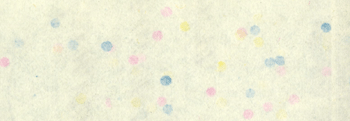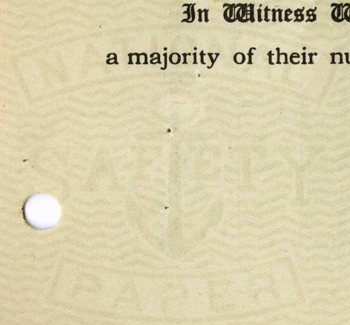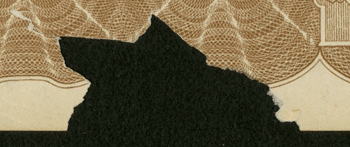Glossary of general terms related to all certificates

Autographs. The signature of practically every individual – famous or not – COULD be significant to someone. The numbers of people who have signed stocks and bonds from railroads easily numbers in the millions. A tiny number of those people were locally, regionally, nationally, or internationally important. This project catalogs the autographs of a few hundred individuals important to railroading, but does NOT catalog every autograph that some seller deemed worthy of a premium price. I must draw the line somewhere. (Shown at right is a typical signature of famous railroad investor Jay Gould.)
This project catalogs autographs only when they: 1) are considered famous enough to be described in multiple autograph sources, 2) appear on several certificates, 3) elevate prices normally paid for their host certificates. Just because a person served in the Civil War or Congress, was a mayor of a large city, or was a local celebrity is not enough to deserve listing. Uncancelled autographs and autographs with minimal cancellations attract higher prices. See Autographs for further discussion.

Corporate seals. Circular seals made for embossing paper were once considered legal requirements to issue and validate stock certificates, bonds and other official corporate documents. Many very early stock certificates display only printed seals (normally red) and therefore must have been legal in some eastern states. As stock trading became electronic, the need for both corporate seals and certificates themselves diminished to the point where both were generally considered unnecessary. Many corporate seals that appear on railroad certificates show dates of incorporation and can serve as important evidence as to the specific company that may been responsible for issuance. Companies often illustrated their corporate seals by embossing multi-pointed paper stars or paper circles onto their certificates. The paper discs or stars were purchased in bulk, often consisting of selections of several colors. Individual colors had no apparent purpose other than decoration. Printers of generic certificates often pre-printed gold circles on their certificates as a place to display corporate seals. While most printers provided separate areas for corporate seals on their certificates, usually at the bottom left, some did not, so placement can sometimes appear random. American Bank Note Company pioneered a method of engraving corporate seals so they appeared three-dimensionally when printed. Embossed seals can be read most easily when lit by oblique light, either front or back. (The example above is of the same seal photographed on the front and back.)
Crisp. A term used by amateur sellers to describe unissued or unfolded certificates.

CUSIP number. An abbreviation for Committee on Uniform Security Identification Procedures, developed in 1967 to identify specific securities in order to speed up movement of certificates through the clearing house system. The earliest railroad certificate known to display a CUSIP number is dated 1970. Learn more about CUSIP numbers elsewhere on this website.
Date of incorporation. The date at which companies were legally authorized to conduct business. Many businesses before the 1850s were incorporated by acts of state, and sometimes Federal, legislatures. In those cases, special acts were introduced, debated, tables occasionally, and sometimes argued before passage. Incorporation dates are considered the dates that special acts were legally signed into law.
Engraving. The method of creating printing plates by carving or etching designs into stone, copper, or steel. (See intaglio printing below.)

Foxing. This is an aging phenomenon that appears on some papers over time. It manifests as brownish splotches which some archivists believe is evidence of a fungal growth. Others believe it is possibly related to microscopic bits of iron and copper left in paper pulp during paper making. Regardless, foxing seems to be related to and exacerbated by high humidity. While foxing decreases the prices collectors will pay for documents with foxing, it does not seem to affect the strength, flexibility of other characteristics of paper. The example shows foxing on a proof of a stock certificate printed on thick, somewhat soft paper. Regular issued certificates of the same variety are printed on better paper and none show foxing.
Handwritten "certificates." Small numbers of certificates, both stocks and bonds, were created entirely by hand. Some were used as mockups for certificates to be created at a later time by printers. However, most were written and issued as genuine, formal, financial documents and were entirely legal. Considered as a group, they are quite rare and collectible, but encountered only sporadically.
Mint condition. Amateur sellers often use this term to describe unissued certificates. Minting is a term used to describe the manufacturing of coins and medals. The term is widely used to describe all sorts of items in excellent condition. While the word is used heavily in philately, its relationship to paper collectibles is both nonsensical and incorrect. Paper is printed, not minted.

Organization date. Many certificates, particularly stocks, display dates when companies were created. "Organization date" may or may not be the same as the date of incorporation when companies became legally-recognized entities. Collectors should be aware that there are substantial disagreements over precise date being described by the term. Never expect published references to agree. Depending upon the sources, "organization date" may refer to dates when:
- investors first met and decided to incorporate
- articles of incorporation were voted on and accepted
- companies filed organization papers with state agencies
- corporate names were reserved
- articles of incorporation were filed
- articles of incorporation were accepted
- corporate seals were received from manufacturers
- corporate charters were granted by state legislatures
- name changes were filed
- name changes were accepted
- name changes were officially granted
- companies were merged or consolidated
Paper.
India paper. This is a tough and very thin paper made from hemp and cotton fibers. It is seen most commonly in Bibles. It is familiar to certificate and stamp collectors because it was used extensively in printing proofs because of its ability to reproduce fine details. Many India paper proofs are found mounted on thicker card stock to keep them from being crumpled during storage.
Parchment paper. True parchment is the untanned skin of sheep, calves, and goats. Parchment paper is a stiff, semi-translucent paper prepared by running sheets of pulp paper through a bath of sulfuric acid or zinc chloride. The paper becomes somewhat heat-, grease- and water-resistant and is frequently used in baking. An orangish-brown variant is often used to print replicas of collectible currency. Collectors should be aware that replicas created with parchment paper are somewhat acidic and should NOT be stored with valuable collectible certificates.

Planchette paper. This was a special paper Invented by the American Bank Note Company in 1891 to help thwart counterfeiting. The paper shows embedded disks of colored paper and widely used to print certificates after 1940. Some certificates display planchettes scattered throughout the body of certificates while others show planchettes concentrated more densely within 1-inch wide horizontal bands (example at right). Planchette paper is easier to identify on stock certificates than on bonds and easier to see on the backs than on the fronts.
Rag and cotton paper. "Rag" is a highly durable, stable paper constructed of cotton and linen fibers. The term originated from the use of fibers recycled from old clothes and textile remnants. Fibers obtained from rags were longer than fibers obtained from the lint collected from cotton processing and that length contributed mightily to durability. Over time, supplies of textile cotton fibers decreased and the percentage of cotton fibers captured from lint increased. While less durable than older rag papers, modern cotton papers still retain excellent longevity. Some high-priced art papers are still made with as much as 75% cotton rag fibers.
Safety paper. This is a bond paper with oriented or watermarked patterns that often contains the words "Safety Paper." Watermarks are rarely seen on stock certificates but encountered somewhat more frequently on certificates such as transfers and receipts. The paper was designed to thwart alterations by exposing erasures and color changes when exposed to chemical ink removers. Safety paper was commonly seen on business checks during the 1960s and 1970s. Today's security papers are more advanced and often contain basketweave patterns that display hidden words when photocopied. (The example below displays an anchor and the words "National Safety Paper.)


Watermarked paper. A special paper designed with thick and thin areas in order to display words or patterns when viewed against transmitted light or placed over dark backgrounds. Watermarks are created during the paper-making process and often identify specific paper mills. Watermarks are seen occasionally on stock certificates. Watermark are usually more identifiable when certificates are viewed from the back because there is usually much less printing. This project does not record watermarks because sellers rarely report such features.

Printer names. Front-line engraving and printing companies responsible for custom certificate designs and production generally displayed their names on certificates, most frequently in a "slug" at the bottom center or bottom left of certificates. At right is a slug of the International Bank Note Company.
Generic certificates frequently display the names of two companies: the printing/engraving company responsible for production and secondary printers (generally local) responsible for adding company names and other details such as share price, capitalization, and state of incorporation. In most cases, primary printer names appear in or below the bottom border design. Secondary printers generally printed their names inside borders at the bottom left.

Wood pulp paper. American Bank Note Company and its major competitors printed certificates on very high quality rag paper that held up well to ageing and repeated folding. Conversely, local printers and many generic printers opted to print on cheaper and thinner pulp paper. The problem with pulp paper is that much of it was produced with a mechanical process that helped break wood fibers apart. Unfortunately, lignin is a component of wood that gives it strength but remains in the pulp. Over time, lignin releases acidic compounds and ultimately lowers the pH of pulp paper, making it increasingly acidic. There is a different chemical pulping process that removes most of the lignin and that kind of pulp paper lasts longer. Nonetheless, even pH neutral pulp paper becomes acidic with age. Acid causes paper to deteriorate and the process is enhanced by exposure to sunlight, ultraviolet light. and heat. In extreme cases, paper becomes as brittle as dried leaves and too delicate to handle.
Even worse for paper collectibles is the fact that acid from pulp paper is highly mobile and moves toward less acidic paper. That acid causes high quality paper to deteriorate, even when not in direct contact. Deterioration is further enhanced by high humidity and poor air flow. Keeping many certificates in close contact with each other is probably not a wise method of long-time storage. Collectors are advised to study the effects of paper acidity and take appropriate action in the event their storage regime is harming more than helping. PLEASE visit a page titled. The Deterioration and Preservation of Paper: Some Essential Facts as well as other preservation-related pages on the Library of Congress website. If someone is a fan of displaying their certificates in frames, they need to be concerned with the amount of sunlight bouncing around a room during the day, neon light at other times, as well as the pH level of matting and framing materials. The safest option, and the one I recommend most heartily, is do not frame originals. It is simply too easy these days to create high-quality copies and frame them. Do you store your certificates in albums and want to know whether the paper separators are acidic? See an article at the Cornell University website titled Library Preservation and Conservation Tutorial.
Printing.
Intaglio printing. (Pronounced "in-TALL-ee-oh", from meaning "engraved work" in Italian.) A printing technique wherein designs and lettering are cut or etched into metal plates. Images are created by rubbing ink into the grooves and pits of the plate and then pressing dampened paper against the plate with great pressure. The softened paper is forced into the grooves and picks up ink in the process. When dried, the ink from vignettes and lettering stands up slightly above the paper surface and can be felt by lightly rubbing fingertips across printed designs and text. Most high-quality printers such as American Bank Note Company and its predecessors used this method for printing stocks and bonds.
Lithograph printing. A method of printing developed in the late 1790s wherein reversed wax-, oil-, or fat-based designs were placed on smooth limestone stone blocks. The printing surface was then treated with a mixture of weak acid and gum arabic which lightly etched the stone. The surface was then dampened and the moisture stuck only to etched surfaces and NOT the oily design. Next, the stone was covered with an oil-based ink which stuck only to the oily design. Finally, paper was pressed against the stone which picked up the ink and gave the viewer a right-reading image. Many early certificates were printed with "lithographic stones," and the process was used as late as the turn of the 19th century. Multi-colored illustrations of the 1870s through the 1890s were created in this manner, especially those that appeared in popular, satirical magazines like Puck and Judge.
Later advances in lithography greatly extended the technology. The earliest metal plates were tin or zinc. Metal plates became thinner and presses faster, ultimately morphing into high-speed offset printing. Offset printing added an extra step whereby a press transferred a right-reading design on the original plate to a reversed inked image on a rubber roller and then subsequently back to a right-reading design on paper. It appears certificate printers used the direct transfer, lithographic process up until about 1904, possibly a bit later, before shifting to the offset process.
Relief printing. Relief printing is the oldest form of printing executed by inking a raised and reversed design or letter and pressing it against some printable substrate such as paper, fabric, or skin. Newspapers of the 1850s through 1870s were often illustrated by woodcut images combined with text printed by movable type. In the case of Leslie's Weekly and Harper's Weekly, timely, one- and two-page images were created by combining many carefully carved woodblocks into one large image. It is possible a few collectible railroad certificates might have used woodcut technology to create some of the more crude vignettes.
I strongly suspect images like these originated from woodcut vignettes and later copied many times by lithograph printers.
Letterpress printing. The bulk of very early railroad certificates in the 1830s and 1840s were created with letter presses and moveable type. The ornamental designs seen on the left sides and centers of many early certificates bear great similarity to each other and were probably created by a handful of type foundries. Certificates printed by letterpress can be identified by viewing certificates from the back. Slight indentations are visible behind letters and especially behind periods and dashes.
Recto. Latin word for the FRONT of a single page document. Also:
- the side of a document meant to be viewed first.
- the page of a manuscript meant to be read first.
- the right page of a book in languages that read left to right.
- the side of a piece of papyrus with the grain running horizontally (left to right).
Revenue imprints. These were pre-printed payments of taxes to the U.S. government to help pay for the Civil War and Spanish-American War. They are seen most frequently on certificates issued between 1865 and 1875. See more information on a special page on this website at Revenue imprints. Many North American railroad companies raised money by selling stocks and bonds in Europe, so substantial numbers of certificates display European revenue imprints. Dutch, French, and English imprints are the most common. None seem to affect collector prices, either positively or negatively.
Revenue stamp. A stamp issued by the U.S. Internal Revenue Service to represent a small tax had been paid. Stamps like this were required on financial documents, including stocks and bonds, to help pay for wars and other costs. Revenue stamps are seen most frequently on stock certificates issued between 1862 and 1871 and between 1898 and 1902. State revenue stamps are also seen occasionally, particularly those from New York.
Silvering. It was expensive for companies to design, engrave, and print customized stocks and bonds. Even in today's world of "on demand" printing, per-page costs are radically higher for small print runs than large print runs. Changes in financial conditions were normal and changes in par values and capitalizations were common. Equally common were changes in officers' facsimile signatures and the types of certificates needed. Instead of ordering new certificates, companies frequently altered existing inventories of certificates by a form of overprinting known as silvering. Small patches of silver ink were applied over obsolete details. Silvering then served as a substrate for printing new details with a second run through a printing press. Silvering can be seen on many certificates and practically every detail was eligible for alteration.
Verso. Latin word for the BACK of a single page document. Also:
- the side of a document meant to be read or viewed second.
- the page of a manuscript meant to be read second.
- the left page of a book in languages that read left to right.
- the side of a piece of papyrus with grain running vertically (up-down).